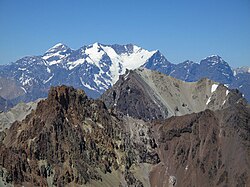geo.wikisort.org - Mountains
Principal Cordillera (Spanish: Cordillera Principal) is the Andean mountain range that makes up the boundary between Central Chile and neighbouring areas of Argentina. It is also a continental divide between the Atlantic and the Pacific watersheds.[1] It extends in a north–south direction in the Argentine provinces of La Rioja, San Juan and Mendoza and the Chilean regions of Valparaíso, Santiago, O'Higgins and Maule. To the east of the Principal Cordillera lies the Frontal Cordillera which is fully in Argentina.[1] Aconcagua, the tallest mountain outside Asia, lies in the Principal Cordillera.[1]

Geological history
What is today the Principal Cordillera was once a depression that accumulated sediments.[2] Lava flows from ancient volcanoes also found their way to the depression. Today these sequences of sedimentary and volcanic rock can be observed high in the Andes, implying their basin was closed and uplifted by tectonic inversion. The said rocks are grouped in the Abanico and Farellones Formation.[2] Tectonic inversion took place 21 to 16 million years (Ma) ago,[2] yet the associated pulse of uplift continued until about 8 Ma ago.[3] The Miocene continental divide was about 20 km to the west of the modern water divide that makes up the Argentina–Chile border.[4] Subsequent river incision shifted the divide to the east leaving old flattish surfaces hanging.[4] Compression and uplift in this part of the Andes has continued into the present.[4] The Principal Cordillera had risen to heights that allowed for the development of valley glaciers about 1 Ma ago.[4]
References
- "Orografía de Mendoza". El Portal de Mendoza (in Spanish). Cámara de Turismo de Mendoza and Cooperativa El Portal de Mendoza. Retrieved June 29, 2019.
- Charrier et al. 2006, pp. 93–94.
- Giambiagi, Laura; Mescua, José; Bechis, Florencia; Hoke, Gregory; Suriano, Julieta; Spagnotto, Silvana; Moreiras, Stella Maris; Lossada, Ana; Mazzitelli, Manuela; Toural Dapoza, Rafael; Folguera, Alicia; Mardonez, Diego; Pagano, Diego Sebastián (2016). "Cenozoic Orogenic Evolution of the Southern Central Andes (32–36°S)". In Folguera, Andrés; Naipauer, Maximiliano; Sagripanti, Lucía; Ghiglione, Matías C.; Orts, Darío L.; Giambiagi, Laura (eds.). Growth of the Southern Andes. Springer. pp. 63–98. ISBN 978-3-319-23060-3.
- Charrier, Reynaldo; Iturrizaga, Lafasam; Charretier, Sebastién; Regard, Vincent (2019). "Geomorphologic and Glacial Evolution of the Cachapoal and southern Maipo catchments in the Andean Principal Cordillera, Central Chile (34°-35º S)". Andean Geology. 46 (2): 240–278. doi:10.5027/andgeoV46n2-3108. Retrieved June 9, 2019.
- Bibliography
- Charrier, Reynaldo; Pinto, Luisa; Rodríguez, María Pía (2006). "3. Tectonostratigraphic evolution of the Andean Orogen in Chile". In Moreno, Teresa; Gibbons, Wes (eds.). Geology of Chile. Geological Society of London. pp. 21–114. ISBN 9781862392199.
На других языках
- [en] Principal Cordillera
[es] Cordillera Principal
La cordillera Principal o cordillera del Límite es una cadena montañosa del sistema andino donde se encuentran las más grandes alturas del continente, entre ellas, el cerro Aconcagua (6.962 m s. n. m.) en Mendoza, el monte Pissis (6.882 m s. n. m.) en La Rioja, el nevado Ojos del Salado (6.894 m s. n. m.) en Catamarca y la Región de Atacama, el cerro Bonete Chico (6.850 m s. n. m.) en La Rioja, el volcán Tupungato (6570 m s. n. m.) en Mendoza y la Región Metropolitana, el cerro Mercedario (6.770 m s. n. m.) en San Juan, entre otros. Su altura disminuye en sentido norte-sur. este o esta generando una estructura desarrollada a expensas del apilamiento tectónico de sedimentitas y volcanitas mesozoicas, realizada durante el período de la orogénea andina. En cuanto al aspecto geomórfico de la Cordillera Principal es consecuencia de un ciclo erosivo de edad pleistocénica relacionado con un ascenso neotectónico, provocando el rejuvenecimiento del terreno. Entonces, podemos decir que la Cordillera Principal se formó en la era Paleozoica.[fr] Cordillère Principale
La cordillère Principale (en espagnol : cordillera Principal) ou cordillère Frontalière (en espagnol : cordillera del Límite) est une chaîne de montagnes du système andin, située à la frontière entre l'Argentine et le Chili. Elle rassemble les plus hauts sommets du continent américain, parmi eux, l'Aconcagua (6 962 m) dans la province de Mendoza, le Monte Pissis (6 792 m) dans les provinces de La Rioja et de Catamarca, le Nevado Ojos del Salado (6 893 m) dans la province de Catamarca et la région d'Atacama, le Cerro Bonete Chico (6 759 m) dans la province de La Rioja, le Tupungato (6 570 m) dans la province de Mendoza et la région métropolitaine de Santiago et le Mercedario (6 720 m) dans la province de San Juan.[ru] Главная Кордильера
Гла́вная Кордилье́ра (исп. Cordillera de los Andes) — водораздельный хребет на границе Чили и Аргентины между 31 и 39° южной широты.Другой контент может иметь иную лицензию. Перед использованием материалов сайта WikiSort.org внимательно изучите правила лицензирования конкретных элементов наполнения сайта.
WikiSort.org - проект по пересортировке и дополнению контента Википедии